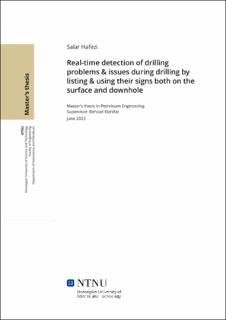| dc.description.abstract | Olje- og gassindustrien er allment anerkjent som en av de farligste sektorene globalt. Prosessen med å utvinne hydrokarboner fra underjordiske reservoarer innebærer betydelige risikoer og usikkerheter. Det er derfor avgjørende å identifisere de underliggende årsakene til disse risikoene og usikkerhetene. Flertallet av slike utfordringer oppstår under boreoperasjoner. Følgelig fungerer boreproblemer som en uvurderlig referanse for ulike disipliner innen petroleumsteknikk. Likevel ligger nøkkelen til å oppnå vellykkede boremål i utformingen av boreprogrammer som tar hensyn til potensielle problemer. Jo mer omfattende listen over problemer er, desto mer nøyaktige kan løsningene være.
Den mest effektive tilnærmingen er å proaktivt unngå scenarier der problemer kan oppstå. Denne forebyggende tilnærmingen fremmer sikrere og mer kostnadseffektive borestrategier. Det er allment anerkjent at selv en enkelt hendelse som resulterer i tap av menneskeliv, miljøkatastrofe eller skade på rigginfrastrukturen kan ha vidtrekkende konsekvenser for hele petroleumsindustrien. Noen vanlige boreproblemer inkluderer fastkjøring av borestrengen, fastklemt borestreng, feil på borestrengen, ustabiliteter i brønnbanen, avvik fra brønnen og kontroll av brønnbanen, forurensning av borevæske, utblåsninger, farlig og grunn gassutslipp, sirkulasjonstap, formasjonsskader, tap av utstyr, personell og kommunikasjon. I tillegg oppstår spesifikke utfordringer ved slankebrønner, coiled tubing-boring, utvidet rekkevidde-boring og underbalanseboring, blant andre. Som ordtaket sier, "forebygging er bedre enn helbredelse". Derfor bør mottoet være å bore trygt, unngå ulykker, hendelser og skade på miljøet samtidig som man minimerer kostnadene. Bærekraftige borepraksiser som prioriterer reduksjon av boreproblemer og tilhørende utgifter bør være den øverste prioriteringen.
Målet med dette programmet er å lage en liste over alle problemene som kan oppstå under boring, samt deres tegn både på overflaten og ned i brønnen, for å identifisere dem ved hjelp av disse tegnene og ved hjelp av filtrering. Den fullstendige metoden og teorien vil bli diskutert i detalj i en senere seksjon. | |
| dc.description.abstract | The oil and gas industry is widely acknowledged as one of the most perilous sectors worldwide. The process of extracting hydrocarbons from underground reservoirs carries significant risks and uncertainties. It is therefore crucial to identify the underlying causes of these risks and uncertainties. The majority of such challenges are encountered during drilling operations. Consequently, drilling problems serve as an invaluable benchmark for various disciplines within petroleum engineering. However, the key to achieving successful drilling objectives lies in designing drilling programs that anticipate potential issues. The more comprehensive the list of problems, the more accurate the solutions can be.
The most effective approach is to proactively avoid scenarios where problems may arise. This preventive approach promotes safer and more cost-effective drilling strategies. It is widely recognized that even a single incident resulting in loss of human life, environmental catastrophe, or damage to rig infrastructure can have far-reaching consequences for the entire petroleum industry. Some common drilling problems include drillpipe sticking, stuck pipe, drillstring failures, wellbore instabilities, hole deviation and well path control, mud contamination, kicks, hazardous and shallow gas release, lost circulation, formation damage, loss of equipment, personnel, and communications. Additionally, specific challenges arise in slim hole drilling, coiled tubing drilling, extended reach drilling, and under-balance drilling, among others. As the saying goes, "prevention is better than cure." Hence, the motto should be to drill safely, avoiding accidents, incidents, and harm to the environment while minimizing costs. Sustainable drilling practices that prioritize the reduction of drilling problems and associated expenses should be the utmost priority.
The aim of this program is to create a list of all the problems that could arise during drilling as well as their signs both on the surface and downhole, in order to determine them using those signs and by the means of filtration, the complete method and the theory of which will be discussed in detail in a subsequent section. | |
